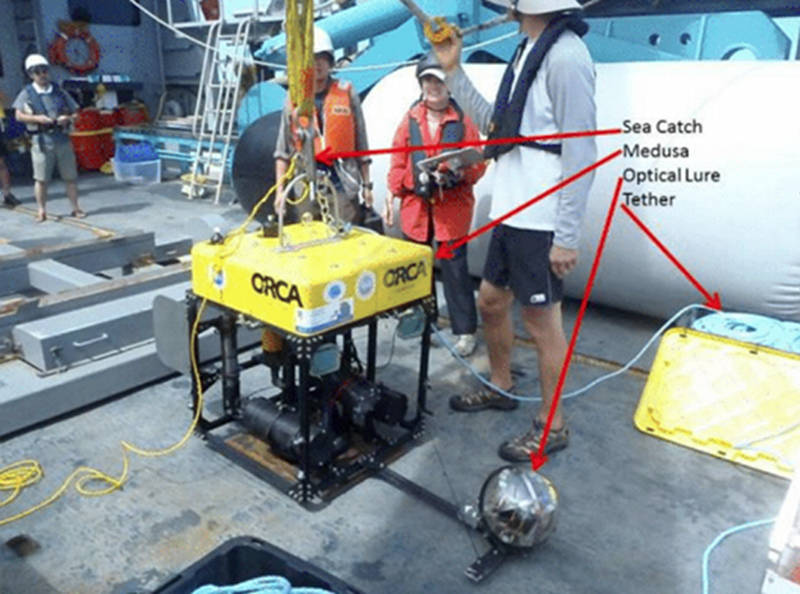Topic
Bioluminescence

The Medusa
Expedition: Light and Life Below the Twilight Zone
 By: Edith (Edie) Widder, Ph.D.
By: Edith (Edie) Widder, Ph.D.
CEO & Senior Scientist, Ocean Research & Conservation Association, Inc.
The Medusa is the stealth camera system that captured the first video of a giant squid in the deep sea. The “stealth” concept behind the system is that it is unobtrusive (it blends in). Remotely operated vehicles (ROVs) usually use bright white lights to penetrate the darkness while exploring the deep sea and ROV hydraulic systems, like those used on the Global Explorer, can be extremely noisy. Given that even animals in the deep, dark ocean need to hide from predators to survive, bright white lights and noise are likely to scare these sensitive deep-sea creatures away. The Medusa creatively uses red lights that are invisible to most deep-sea inhabitants and has silent thrusters, so it can serve as a stealthy observer of life — and light — below the Twilight Zone.
To attract animals into the field of view of its camera, the Medusa uses either bait attached to a bar mounted in front of the camera or an optical lure like the one used during the giant squid expedition. This optical lure is also known as the electronic jellyfish (e-jelly). We designed it to imitate the bioluminescent display of the common deep-sea jellyfish Atolla wyvillei. This display is sometimes called a ”bioluminescent burglar alarm.” It consists of a flashing wave of light that pinwheels around the surface of the jellyfish’s body (the bell). We believe it functions as a last ditch “scream” for help when the jellyfish is caught in the clutches of a predator. The display serves to attract the attention of a larger predator that may attack the jellyfish’s attacker, providing the jellyfish an opportunity to escape. The first time this lure was used during a 2012 giant squid hunt off Japan, the camera recorded three different sightings of the giant squid during a single deployment.
The Medusa is attached to a float at the surface by a line of any length up to 2,000 meters (6,560 feet). This is the depth limit of the Medusa. It takes a team to deploy and recover the Medusa. Part of the crew controls the ship’s A-frame and winch to lower the Medusa into the sea, while other team members slowly let out the long line attached to the float. Once the Medusa is at its resting depth, we are able to track its location using a satellite-tracking beacon attached to the float. The Medusa is left to collect data for up to 30 hours, and is then recovered by the team using the ship’s A-frame and winch again.
We designed the Medusa carefully based on deep-sea animal adaptations. The low-light camera system and far-red (almost infrared) light illumination on it allow us to record bioluminescence and observe animal behavior unobtrusively. The battery pack on the Medusa allows it to record up to 30 hours of video in high definition. These specialized features help us make exciting new discoveries, and share them with the rest of the world!
